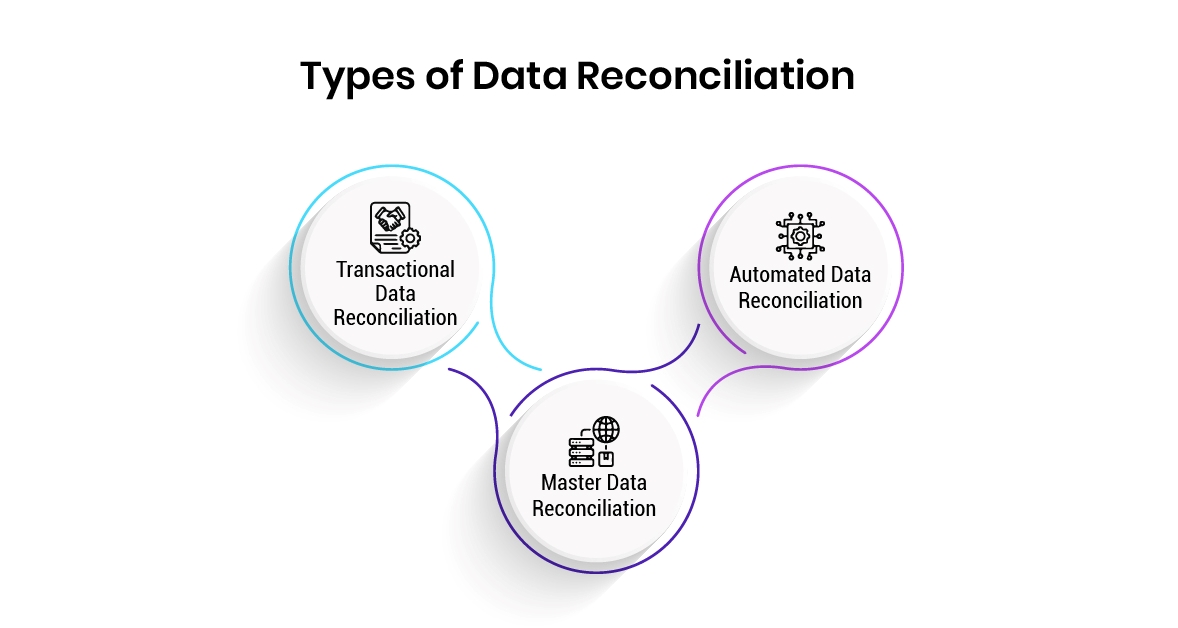
Imagine a world where healthcare is error-free, e-commerce platforms offer consistent pricing, financial institutions have precise transaction records, and energy grids function flawlessly. Data reconciliation is the silent savior ensuring data accuracy and consistency, saving lives, growing businesses, maintaining financial stability, and keeping our lights on. This blog explores its importance and application in healthcare and IT, along with solutions to overcome challenges.
Data Reconciliation Explained
Data reconciliation is a set of tools and technologies used to verify the accuracy and consistency of data. This process is essential during data migrations between systems and in routine checks of production data, order data, or customer contact details. It ensures that data remains reliable and trustworthy for various applications. Types of Data Reconciliation:

- Transactional Data Reconciliation: Ensures data accuracy for business intelligence by identifying and rectifying discrepancies in large datasets.
- Master Data Reconciliation: Aligns core data between source and target systems, focusing on security and authorization.
- Automated Data Reconciliation: Efficiently automates reconciliation within large data warehouses, keeping stakeholders informed through separate metadata tables.
A Glimpse into History
Data reconciliation has evolved alongside the complexity of data management over the years. In the early days of computing, ensuring data consistency was a time-consuming and error-prone process that relied on manual inspections. However, with the advancement of new technology, automatic data reconciliation systems have become very necessary. It's like going from counting sheep one by one to keeping track of the flock with a high-speed calculator.
The Importance of Data Reconciliation
As per Gartner's projections, it is anticipated that by 2023, over 30% of successful cyberattacks targeting enterprises will exploit their shadow IT resources. Shadow IT pertains to the unauthorized or unmonitored usage of software and hardware within an organization. A significant portion of these security breaches can be attributed to data discrepancies and inconsistencies, underscoring the urgent requirement for robust data reconciliation measures.
-
Ensuring Accurate Decision-Making
Accurate and timely data plays an important role in making informed decisions. For example, data on customer preferences informs marketing campaigns, and operational data improves process efficiency and resource allocation. Conversely, inaccurate data can hinder decision-making processes, reduce the visibility of opportunities, and negatively impact customer experiences and relationships. -
Preventing Catastrophic Errors
In severe circumstances, data mistakes can have disastrous effects, such as locking consumers out of their accounts or preventing them from accessing their assets. These mistakes can lead to lost revenue and considerable reputational harm. Data reconciliation assists in finding and correcting mistakes, strengthening an organization's defense against cyberattacks on shadow IT resources, and, as a result, limiting the possible impact of such security breaches. -
Business-as-Usual Reconciliation
Performing dynamic and automated data reconciliation regularly is essential as part of a company's business-as-usual (BAU) activities to maintain data accuracy and consistency. This process should be tailored to an organization's specific needs and requirements.
When is Data Reconciliation Needed?
Data reconciliation is a necessary process in a range of contexts, and two notable scenarios warrant discussion: healthcare and information technology (IT).
Data Reconciliation in Healthcare
-
Enhancing Patient Safety Through Medication Reconciliation
Medication errors are a significant concern in healthcare, with potentially life-threatening consequences. One key area where data reconciliation plays a crucial role in healthcare is medication reconciliation. This process involves comparing a patient's current list of medications with any newly prescribed ones to identify discrepancies and ensure patient safety.
The Challenge
In a large urban hospital, medication reconciliation was primarily a manual process, often prone to human error and omissions. Discrepancies between the patient's current medication list and the prescriptions provided by various healthcare professionals were common, increasing the risk of medication errors.
The Data Reconciliation Solution
The hospital implemented an automated data reconciliation system to enhance medication safety. This system integrated patient records, pharmacy data, and prescription information. It cross-referenced the patient's medication history with new prescriptions, highlighting discrepancies and potential interactions.
- Medication errors decreased significantly, leading to improved patient safety.
- The automated system reduced the time and effort required for manual reconciliation, allowing healthcare professionals to focus on patient care.
- The hospital reported fewer adverse drug events and hospital readmissions, resulting in cost savings.
Data Reconciliation in IT
-
Streamlining Data Integration for a Global E-commerce Platform
A multinational e-commerce company faced the challenge of integrating data from various sources, including multiple regional websites, point-of-sale systems, and third-party vendors. Data reconciliation became crucial to ensure consistent product information, pricing, and customer details across all platforms.
The Challenge
With a decentralized approach to data management, the e-commerce company struggled to maintain data consistency and accuracy. Each regional website had its databases, leading to discrepancies in product catalogs, pricing, and inventory levels. These discrepancies affected customer experiences and hindered global marketing efforts.
The Data Reconciliation Solution
The company implemented a comprehensive data reconciliation solution that connected all regional databases to a centralized platform. This solution integrated product information, pricing data, and customer details, ensuring that discrepancies were identified and resolved in real-time.
- Consistent product information and pricing across all regional websites led to improved customer trust and satisfaction.
- Real-time data reconciliation allowed the company to respond rapidly to market changes, such as price adjustments and product availability.
- Marketing efforts became more effective as accurate customer data facilitated targeted campaigns and personalized recommendations.
End Notes
Data reconciliation is a crucial process to guarantee the precision and uniformity of data in diverse sectors. Whether it's about upholding patient well-being in the medical field or simplifying data fusion for an international e-commerce enterprise, data alignment assumes an important function in sustaining precision, uniformity, and, fundamentally, operational triumph. These instances exemplify the significance of applying effective data alignment strategies to surmount obstacles and accomplish data-powered objectives, which, in turn, results in enhanced decision-making and superior outcomes.
































